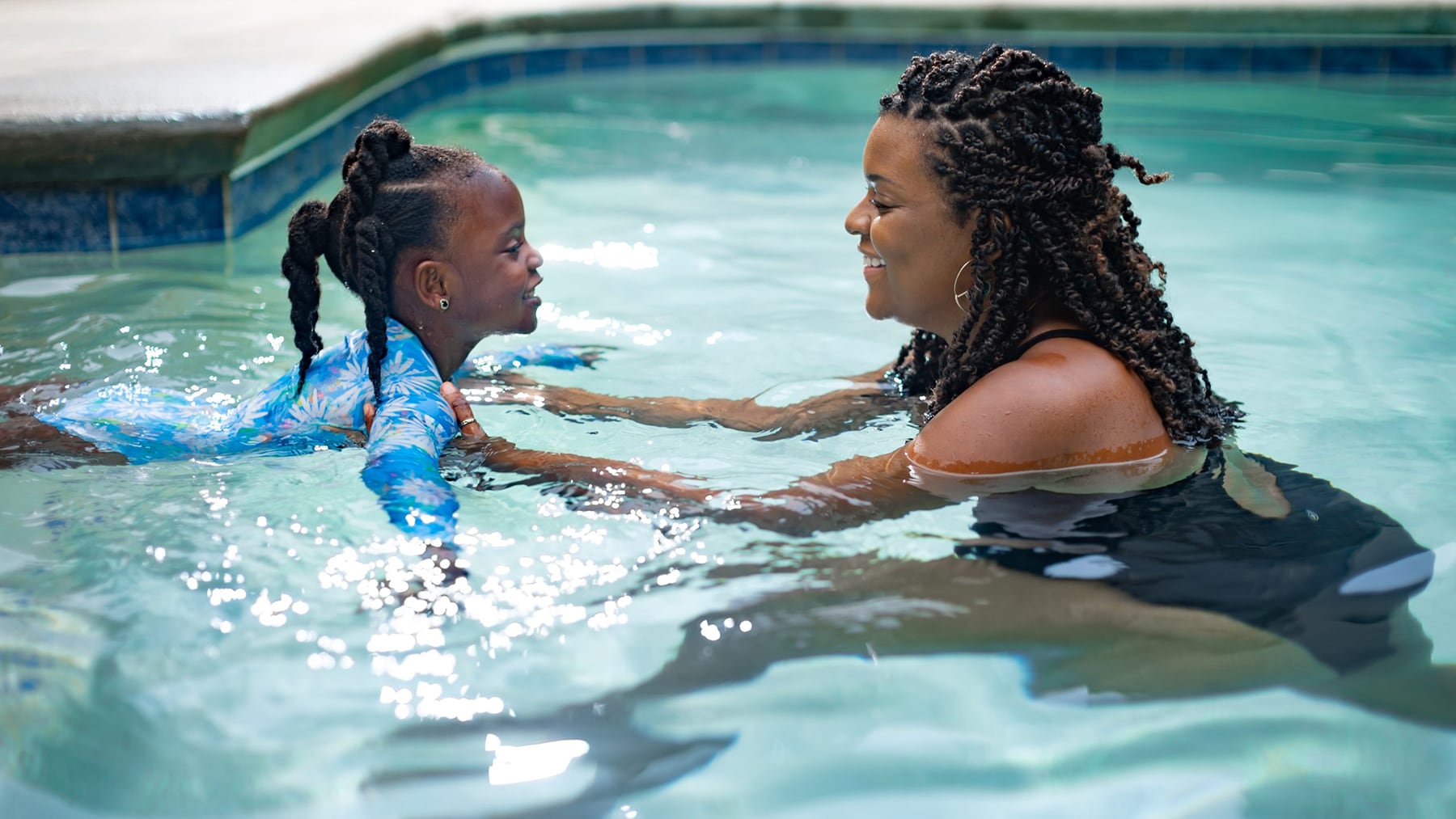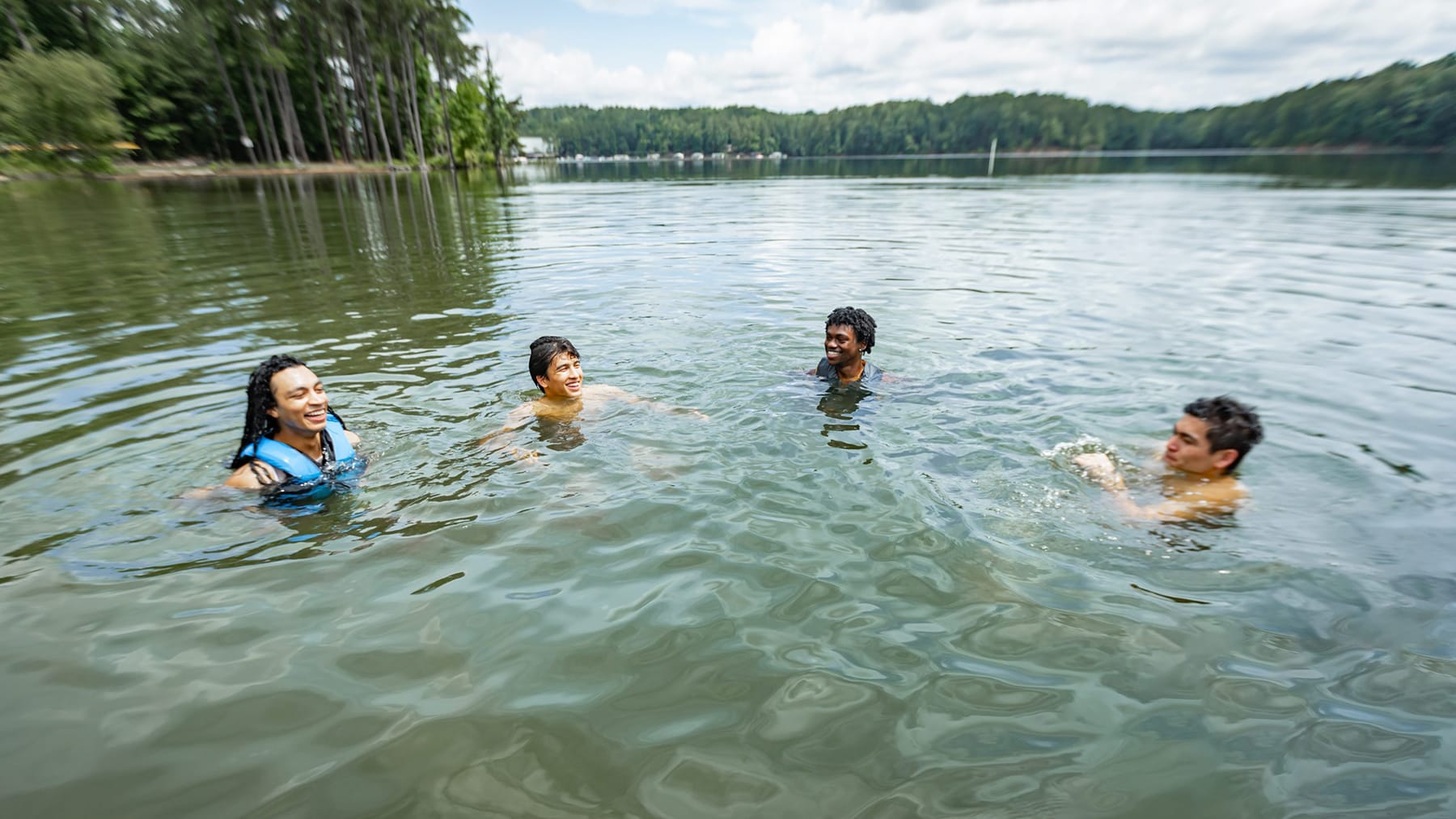Key points
- More children ages 1–4 die from drowning than any other cause of death.
- Drowning happens in seconds and is often silent.
- Drowning can happen to anyone, any time there is access to water.

You can prevent drowning

Learn basic swimming and water safety skills
Formal swimming lessons can reduce the risk of drowning. 12345Children who have had swimming lessons still need close and constant supervision when in or around water.
Build fences that fully enclose pools
Construct and use a four-sided fence that is at least four feet in height and fully encloses the pool. The fence should separate the pool from the house, with self-closing and self-latching gates. Remove all toys from the pool area that might attract children to the pool when the pool is not in use.
Supervise closely
Designate a responsible adult to supervise closely and constantly when children are in or near water (including bathtubs). You can assign a specific adult to supervise each child when they have access to water. Adults watching kids in or near water should avoid distracting activities like reading, using the phone, and consuming alcohol or drugs, because drowning happens quickly and quietly.16
After swim time is over, shut and lock doors that give access to water. Be proactive and learn about any risks when visiting another home or unfamiliar location. Adults should supervise children closely even when lifeguards are present.
Wear a life jacket
Life jackets reduce the risk of drowning while boating for people of all ages and swimming abilities. Life jackets should be used by children for all activities while in and around natural water.
Life jackets can also be used by weaker swimmers of all ages in and around natural water and swimming pools. Do not rely on air-filled or foam toys, as these are not safety devices.17
Learn CPR
Your CPR skills could save someone's life in the time it takes for paramedics to arrive. Many organizations such as American Red Cross and American Heart Association offer CPR training courses, both online and in-person.
Know the risks of natural waters

Lakes, rivers, and oceans have hidden hazards such as dangerous currents or waves, rocks or vegetation, and limited visibility.8 Check the forecast before activities in, on, or near water. Local weather conditions can change quickly and cause dangerous flash floods, strong winds, and thunderstorms with lightning strikes.
Avoid alcohol
Avoid drinking alcohol before or during swimming, boating, or other water activities. Alcohol impairs judgment, balance, and coordination.9 Do not drink alcohol while supervising children.
Use the buddy system
Always swim with a buddy. Choose swimming sites that have lifeguards when possible. The buddy system is especially beneficial for people with seizure disorders or other medical conditions that increase their risk of drowning.1
Take additional precautions for medical conditions
Know if your medical condition might increase your risk for drowning and take extra care. For example, if you or a family member have a seizure disorder like epilepsy, have one-on-one supervision around water. People with seizure disorders can also consider taking a shower rather than a bath. Take extra precaution around water if you or a family member has other conditions that can increase drowning risk, like heart conditions or autism.1101112
Consider the effects of medications
Avoid swimming if you take medications that impair your balance, coordination, or judgement. These side effects increase the risk of drowning. Several medications can produce these side effects, such as those used for anxiety and other mental health conditions.13
Don't hyperventilate or hold your breath for a long time
Do not hyperventilate before swimming underwater or try to hold your breath underwater for long periods of time. This can cause you to pass out and drown. This is sometimes called "hypoxic blackout" or "shallow water blackout".14
Resources
- Water Safety USA is a roundtable of longstanding national nonprofit and governmental organizations with a strong record of providing drowning prevention and water safety programs, including public education.
- Safe Kids Worldwide is a nonprofit organization working to help families and communities keep kids safe from injuries, including drowning.
- The YMCA is a nonprofit that focuses on strengthening communities through youth development, healthy living, and social responsibility. See their drowning prevention page for tips about how to be safe around water.
- Healthychildren.org, a website from the American Academy of Pediatrics (AAP), contains helpful information for parents on many topics, including water safety advice. Resources in Spanish are included.
- The Drowning Chain of Survival is composed of five steps that can help to guide the prevention of drowning, as well as rescue and recovery when a drowning incident occurs.
- The American Academy of Pediatrics provides more detailed information about prevention of drowning in the AAP 2019 Policy Statement.
Get email updates
Sign up for our email newsletter below.
- Denny SA, Quan L, Gilchrist J, McCallin T, Shenoi R, Yusuf S, Hoffman B, Weiss J. American Academy of Pediatrics (AAP) – Council on Injury, Violence, and Poison Prevention. Policy Statement – Prevention of Drowning. Pediatrics 2019;143(5): e20190850.
- Brenner RA, Taneja GS, Haynie DL, Trumble AC, Qian C, Klinger RM, Klevanoff MA. Association between swimming lessons and drowning in childhood: A case-control study. Archives of Pediatrics & Adolescent Medicine 2009;163(3):203–210.
- Yang L, Nong QQ, Li CL, Feng QM, Lo SK. Risk factors for childhood drowning in rural regions of a developing country: a case–control study. Injury Prevention 2007;13(3):178–182.
- Petrass LA, Blitvich JD. Preventing adolescent drowning: Understanding water safety knowledge, attitudes and swimming ability. The effect of a short water safety intervention. Accident Analysis & Prevention 2014;70:188–194.
- Wallis BA, Watt K, Franklin RC, Taylor M, Nixon JW, Kimble RM. Interventions associated with drowning prevention in children and adolescents: systematic literature reviewexternal icon. Injury Prevention 2015;21:195–204.
- Moran K, Stanley T. Toddler drowning prevention: Teaching parents about water safety in conjunction with their child's in-water lessons. International Journal of Injury Control and Safety Promotion 2006;14(4):254–256.
- Cummings P, Mueller BA, Quan L. Association between wearing a personal floatation device and death by drowning among recreational boaters: a matched cohort analysis of United States Coast Guard data. Injury Prevention 2011;17(3):156–159.
- Mackay JM, Samuel E, Green A. Hidden Hazards: An Exploration of Open Water Drowning and Risks for Children. Safe Kids Worldwide 2018. Accessed 4 May 2021.
- Driscoll TR, Harrison JA, Steenkamp M. Review of the role of alcohol in drowning associated with recreational aquatic activity. Injury Prevention 2004;10(2):107–113.
- Guan J, Li G. Injury Mortality in Individuals with Autism. American Journal of Public Health 2017;107(5):791–793.
- Guan J, Li G. Characteristics of unintentional drowning deaths in children with autism spectrum disorder. Injury Epidemiology 2017;4(32):1–4.
- Semple-Hess J, Campwala R. Pediatric submersion injuries: emergency care and resuscitation. Pediatric Emergency Medicine Practice 2014;11(6)1–22.
- Pajunen T, Vuori E, Vincenzi FF, Lillsunde P, Smith G, Lunetta P. Unintentional drowning: Role of medicinal drugs and alcohol. BMC Public Health 2017;17(388):1–10.
- Pearn JH, Franklin RC, Peden AE. Hypoxic blackout: diagnosis, risks, and prevention. International Journal of Aquatic Research and Education. 2015;9(3):9.
